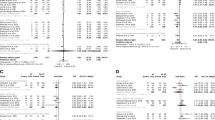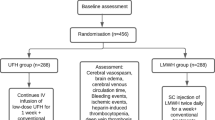Abstract
Background
To reassess the use of antifibrinolytics (AF) in the management of aneurysmal subarachnoid hemorrhage (SAH) in the setting of present-day treatment strategies.
Method
The authors conducted a systematic review of the literature and a meta-analysis. They reviewed the PubMed database and conducted a manual review of article bibliographies.
Results
Using a pre-specified search strategy, 17 relevant studies involving a total of 2,872 patients with SAH at baseline, from which data of 1,380 patients having received AF, were included in a meta-analysis. Pooled odds ratios of the impact of AF on functional outcomes, rebleeding, and cerebral infarction were calculated. Short-term use of AF (72 h or less) associated with medical prevention of ischemic deficit seems to yield better results on functional outcome than long-term use of AF, especially if not associated with a medical prevention of ischemic deficit. The risk of cerebral infarction is not increased by the short-term use of AF and the risk of rebleeding is decreased independently of the length of AF use.
Conclusions
The use of AF should be reconsidered in the setting of modern-era treatment strategies, as the short-term use associated with medical prevention of ischemic deficit decreases the rate of rebleeding and does not increase the risk of cerebral infarction, thus potentially yielding better protection against poor functional outcome.



Similar content being viewed by others
References
Ameen AA, Illingworth R (1981) Anti-fibrinolytic treatment in the preoperative management of subarachnoid hemorrhage caused by ruptured intracranial aneurysm. J Neurol Neurosurg Psy 44:220–226
Chandra B (1978) Treatment of subarachnoid hemorrhage from ruptured intracranial aneurysm with tranexamic acid: a double-blind clinical trial. Ann Neurol 3:502–504
Chowdhary UM, Carey PC, Hussein MM (1979) Prevention of early recurrence of spontaneous subarachnoid haemorrhage by epsilon-aminocaproic acid. Lancet 1:741–743
Feigin VL, Rinkel GJ, Algra A, Vermeulen M, van Gijn J (1998) Calcium antagonists in patients with aneurysmal subarachnoid hemorrhage: a systematic review. Neurology 50:876–883
Fodstad H, Liliequist B, Schannong M, Thulin CA (1978) Tranexamic acid in the preoperative management of ruptured intracranial aneurysms. Surg Neurol 10:9–15
Fodstad H, Forssell A, Liliequist B, Schannong M (1981) Antifibrinolysis with tranexamic acid in aneurysmal subarachnoid hemorrhage: a consecutive controlled clinical trial. Neurosurgery 8:158–165
Fogelholm R, Hernesniemi J, Vapalahti M (1993) Impact of early surgery on outcome after aneurysmal subarachnoid hemorrhage. A population-based study. Stroke 24:1649–1654
Gelmers HJ (1980) Prevention of recurrence of spontaneous subarachnoid hemorrhage by tranexamic acid. Acta Neurochir 52:45–50
Gibbs JR, O’Gorman P (1967) Fibrinolysis in subarachnoid hemorrhage. Postgrad Med J 43(506):779–784
Girvin JP (1973) The use of antifibrinolytic agents in the preoperative treatment of ruptured intracranial aneurysms. Trans Am Neurol Assoc 98:150–152
Hijdra A, Vermeulen M, van Gijn J, van Crevel H (1987) Rerupture of intracranial aneurysms: a clinicoanatomic study. J Neurosurg 67:29–33
Hillman J, von Essen C, Leszniewski W et al (1988) Significance of “ultra-early” rebleeding in subarachnoid hemorrhage. J Neurosurg 68:901–907
Hillman J, Fridriksson S, Nilsson O, Yu Z, Saveland H, Jakobsson KE (2002) Immediate administration of tranexamic acid and reduced incidence of early rebleeding after aneurysmal subarachnoid hemorrhage: a prospective randomized study. J Neurosurg 97:771–778
Kassell NF, Peerless SJ, Durward QJ, Beck DW, Drake CG, Adams HP (1982) Treatment of ischemic deficits from vasospasm with intravascular volume expansion and induced arterial hypertension. Neurosurgery 11:337–343
Kassell NF, Torner JC, Jane JA et al (1990) The International Cooperative Study on the Timing of Aneurysm Surgery. Part 2: Surgical results. J Neurosurg 73:37–47
Kaste M, Ramsay M (1979) Tranexamic acid in subarachnoid hemorrhage. A double-blind study. Stroke 10:519–522
Leipzig TJ, Redelman K, Horner TG (1997) Reducing the risk of rebleeding before early aneurysm surgery: a possible role for antifibrinolytic therapy. J Neurosurg 86:220–225
Locksley HB (1966) Natural history of subarachnoid hemorrhage, intracranial aneurysms and arteriovenous malformations. J Neurosurg 25:321–368
Maurice-Williams RS (1978) Prolonged antifibrinolysis: an effective nonsurgical treatment for ruptured intracranial aneurysms? Br Med J 1:945–947
Milhorat TH, Krautheim M (1986) Results of early and delayed operations for ruptured intracranial aneurysms in two series of 100 consecutive patients. Surg Neurol 26:123–128
Ohkuma H, Tsurutani H, Suzuki S (2001) Incidence and significance of early aneurysmal rebleeding before neurosurgical or neurological management. Stroke 32:1176–1180
Okamoto S, Hijikata-Okunomiya A, Wanaka K, Okada Y, Okamoto U (1997) Enzyme controlling medicines: introduction. Semin Thromb Hemost 23:493–501
Owen CA Jr, Bowie EJW (1979) Surgical hemostasis. J Neurosurg 51:137–146
Pradilla G, Chaichana KL, Hoang S, Huang J, Tamargo RJ (2010) Inflammation and cerebral vasospasm after subarachnoid hemorrhage. Neurosurg Clin N Am 21:365–379
25-Review Manager (RevMan) [Computer program]. Version 5.0. Copenhagen: The Nordic Cochrane Centre, The Cochrane Collaboration, 2008
Roos YB, for the STAR-study group (2000) Antifibrinolytic treatment in aneurysmal subarachnoid haemorrhage: a randomized placebo-controlled trial. Neurology 54:77–82
27-Roos YB, Rinkel GJE, Vermeulen M, Algra A, van Gijn J. Antifibrinolytic therapy for aneurysmal subarachnoid haemorrhage. Cochrane Database of Systematic Reviews 2003, Issue 2. Art. No.: CD001245. doi:10.1002/14651858.CD001245
Sengupta RP, So SC, Villarejo Ortega FJ (1976) Use of epsilon aminocaproic acid (EACA) in the preoperative management of ruptured intracranial aneurysms. J Neurosurg 44:479–484
Shucart WA, Hussain SK, Cooper PR (1980) Epsilon-aminocaproic acid and recurrent subarachnoid hemorrhage: a clinical trial. J Neurosurg 53:28–31
Starke RM, Kim GH, Fernandez A (2008) Impact of a protocol for acute antifibrinolytic therapy on aneurysm rebleeding after subarachnoid hemorrhage. Stroke 39:2617–2621
Tovi D, Nilsson IM, Thulin CA (1973) Fibrinolytic activity of the cerebrospinal fluid after subarachnoid hemorrhage. Acta Neurol Scand 49:1–9
Tsementzis SA, Hitchcock ER, Meyer CH (1990) Benefits and risks of antifibrinolytic therapy in the management of ruptured intracranial aneurysms. A double-blind placebo-controlled study. Acta Neurochir 102:1–10
Van Rossum J, Wintzen AR, Endtz LJ, Schoen JHR, de Jonge H (1977) Effect of tranexamic acid on rebleeding after subarachnoid hemorrhage: a double-blind controlled clinical trial. Ann Neurol 2:238–242
Vermeulen M, Lindsay KW, Murray GD et al (1984) Antifibrinolytic treatment in subarachnoid hemorrhage. N Eng J Med 311:432–437
Whitfield PC, Moss H, O’Hare D et al (1996) An audit of aneurysmal subarachnoid haemorrhage: earlier resuscitation and surgery reduces inpatient stay and deaths from rebleeding. J Neurol Neurosurg Psy 60:301–306
Yusuf S, Peto R, Lewis J, Collins R, Sleight P (1985) Beta blockade during and after myocardial infarction: an overview of the randomized trials. Prog Cardiovasc Dis 27(5):335–371
Zacharia BE, Hickman ZL, Grobelny BT, DeRosa P, Kotchetkov I, Ducruet AF, Sander Connolly S Jr (2010) Epidemiology of aneurysmal subarachnoid hemorrhage. Neurosurg Clin N Am 21:221–233, Review
Acknowledgements
We would like to express our gratitude to Dr Andrew F. Ducruet from Columbia University, NY, USA, for his prompt response to our questions.
Conflicts of interest
None.
Sources of funding
None.
Financial disclosure
None.
Author information
Authors and Affiliations
Corresponding author
Additional information
Comment
The authors’ meta-analysis shows a decrease in rehemorrhage rates without any clear increase in stroke risk using short-term (<3 days) antifibrinolytic therapy (AF). The meta-analysis shows a trend towards fewer poor outcomes with short-term use of AF. In the older literature, patients were often actively dehydrated as part of the SAH management principles of the time, since hyponatremia was thought to be due to SIADH. Following the redescription of cerebral salt wasting and the description of hyperdynamic therapy in the early 1980s, patients were then hydrated following SAH, and this may well contribute to reduction in ischemic events over time. The current meta-analysis includes two recent papers not considered in the 2003 Cochrane Review: Hillman in 2002 and Starke in 2008. These two papers contain 753 patients and represent the most up-to-date treatment of subarachnoid hemorrhage. In the authors’ analysis, the results of short-term AF treatment and medical prevention of vasospasm described in these articles compare favorably to prior literature.
Patrick J. Connolly
Christopher M. Loftus
Philadelphia, Pennsylvania, USA
Rights and permissions
About this article
Cite this article
Gaberel, T., Magheru, C., Emery, E. et al. Antifibrinolytic therapy in the management of aneurismal subarachnoid hemorrhage revisited. A meta-analysis. Acta Neurochir 154, 1–9 (2012). https://doi.org/10.1007/s00701-011-1179-y
Received:
Accepted:
Published:
Issue Date:
DOI: https://doi.org/10.1007/s00701-011-1179-y




